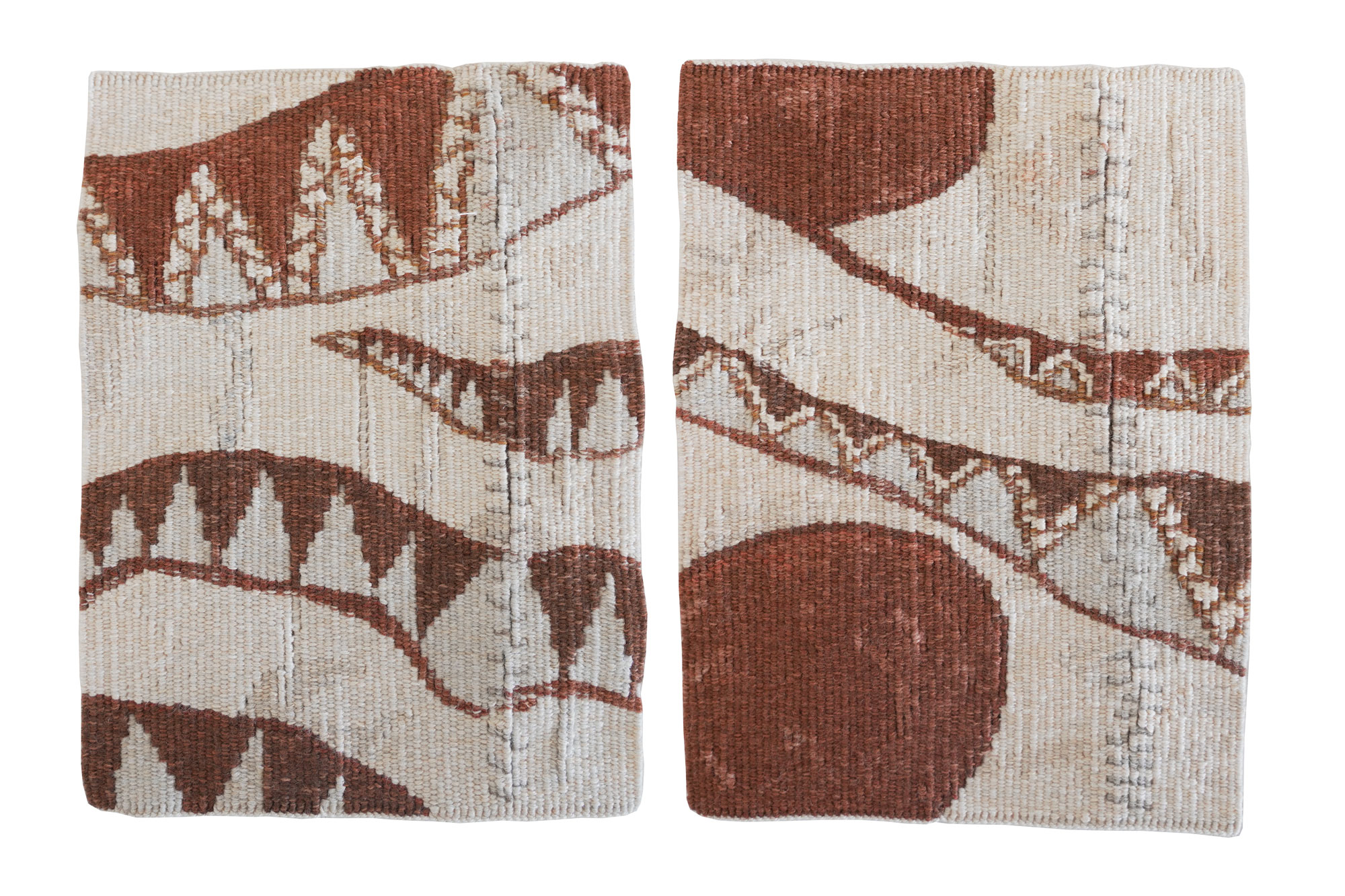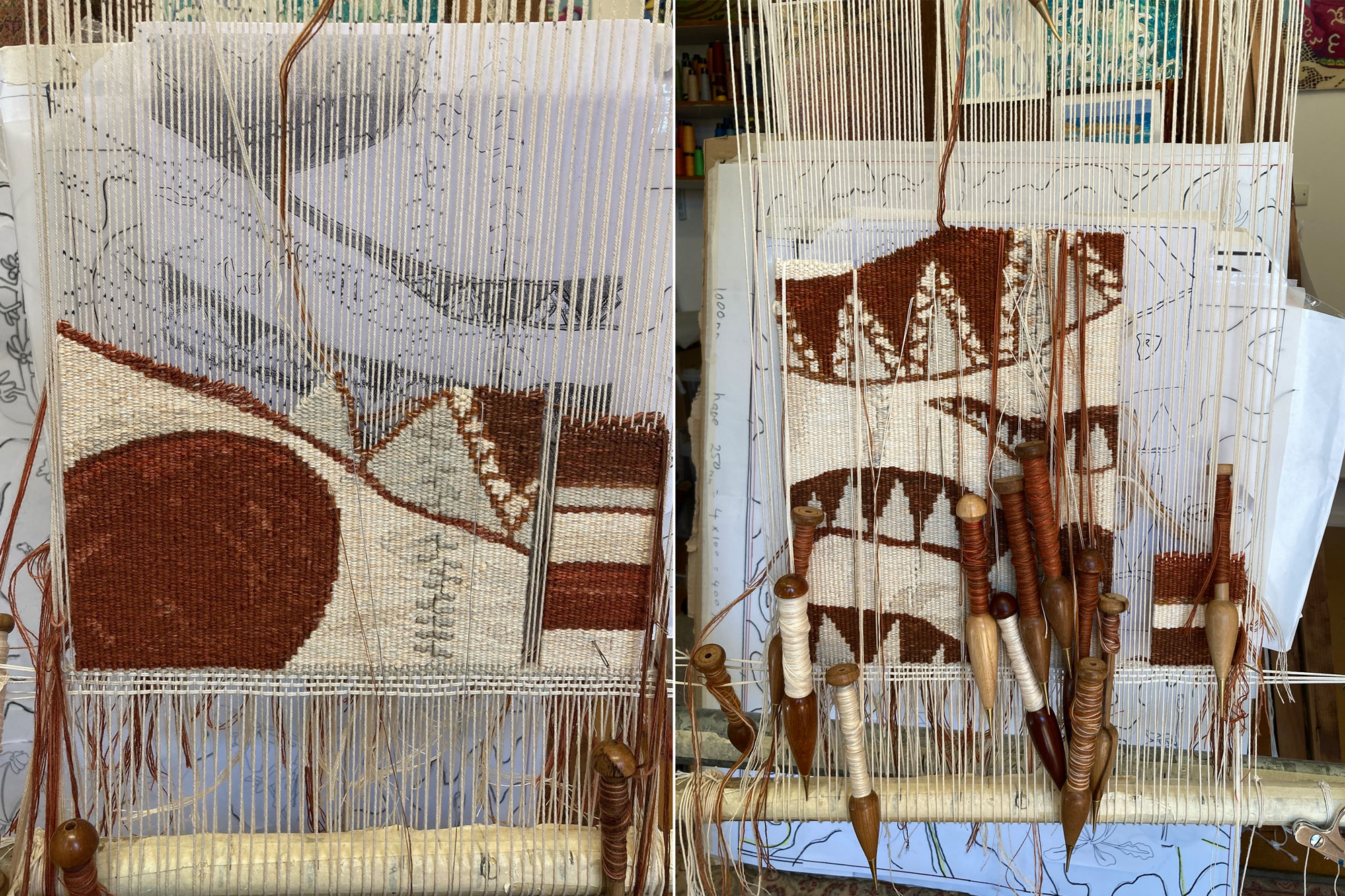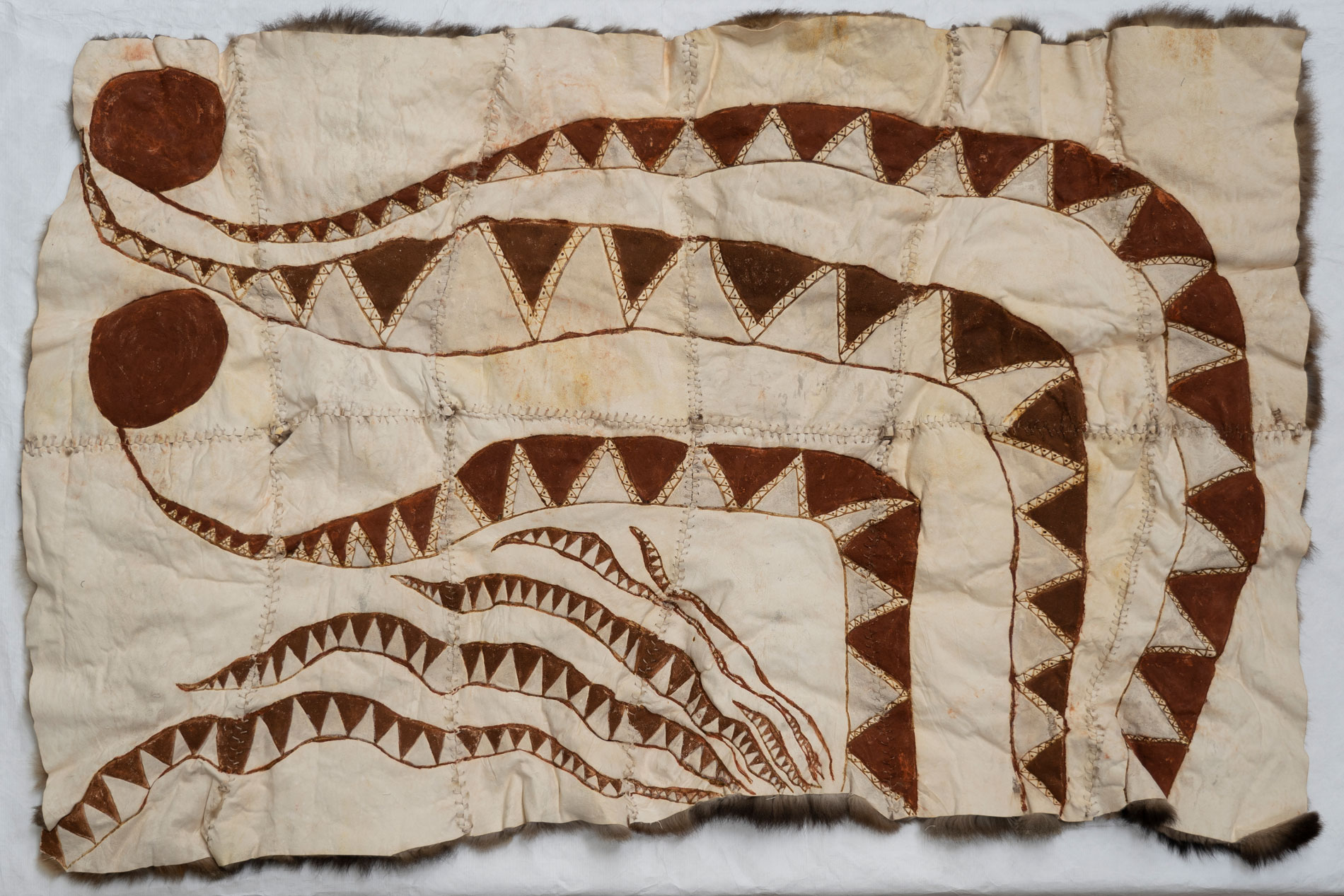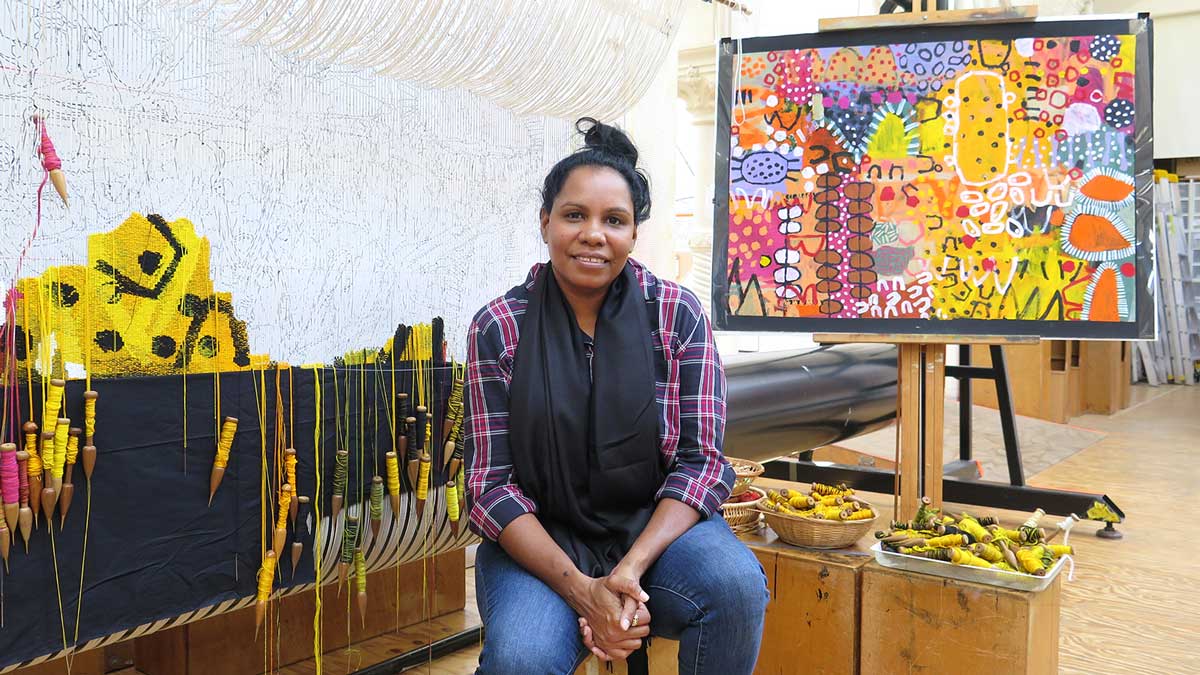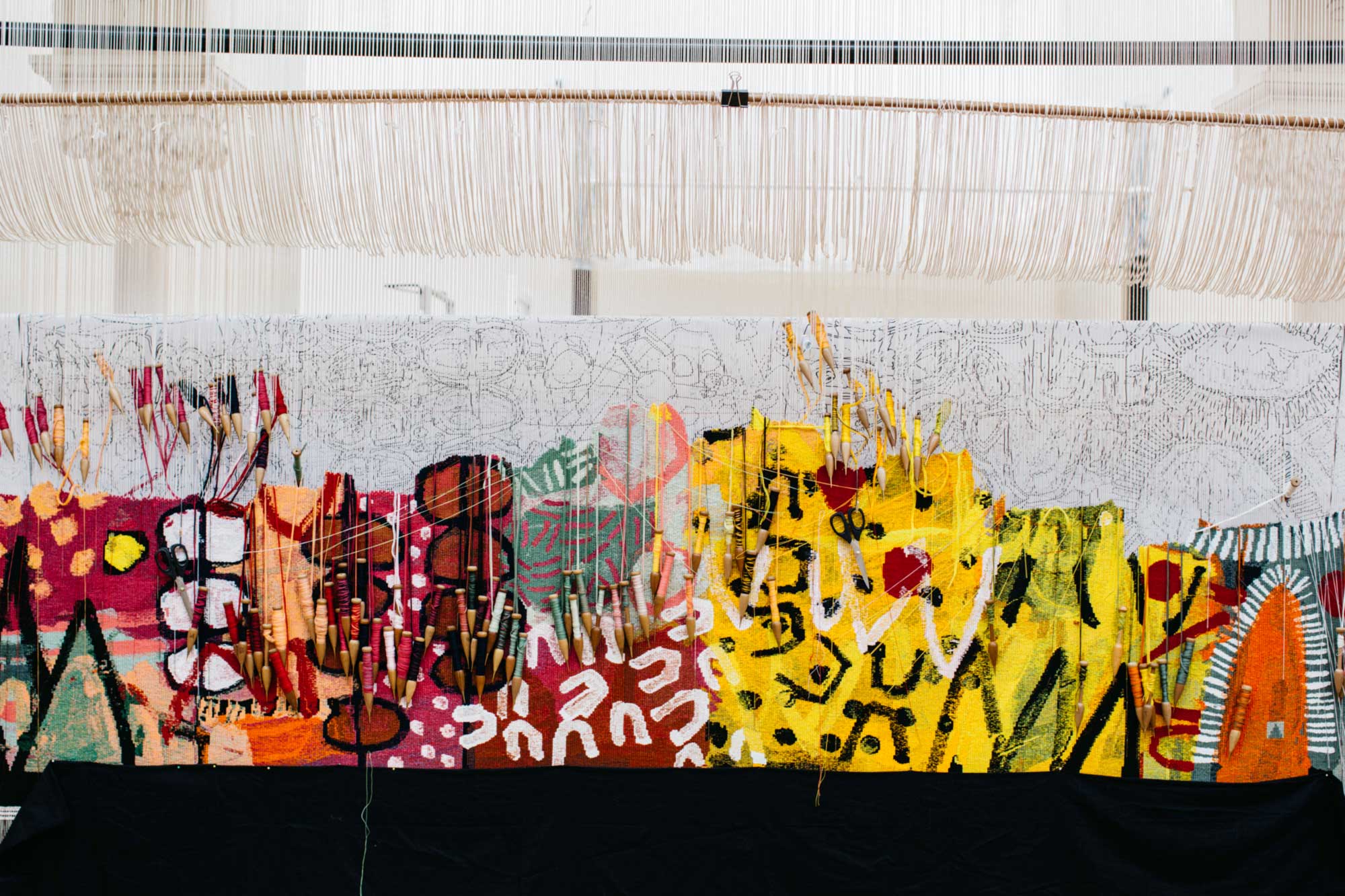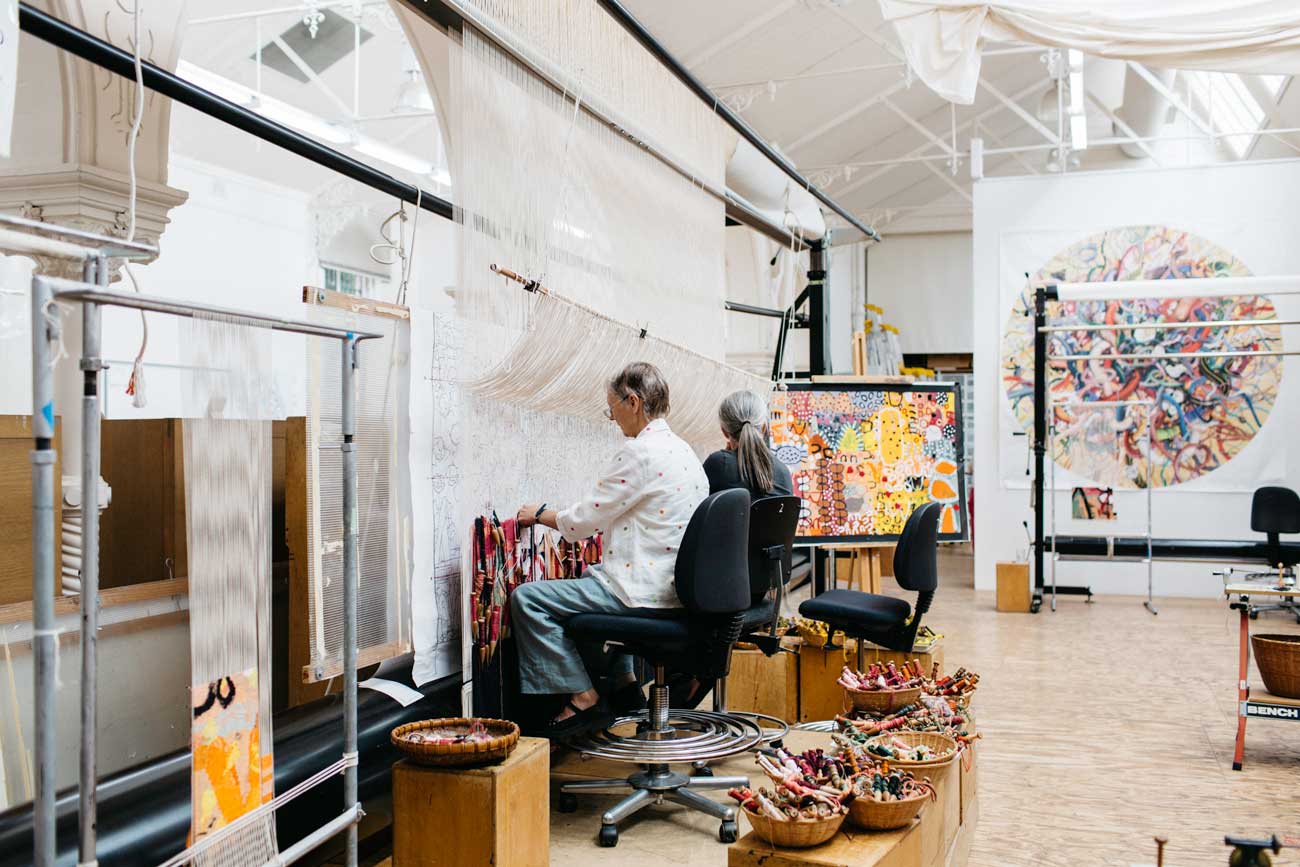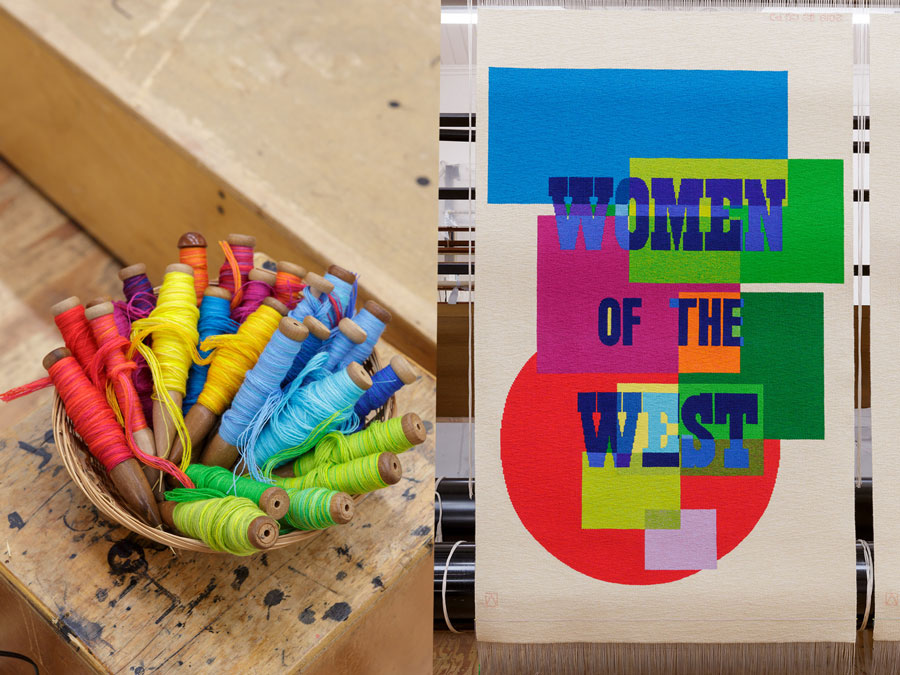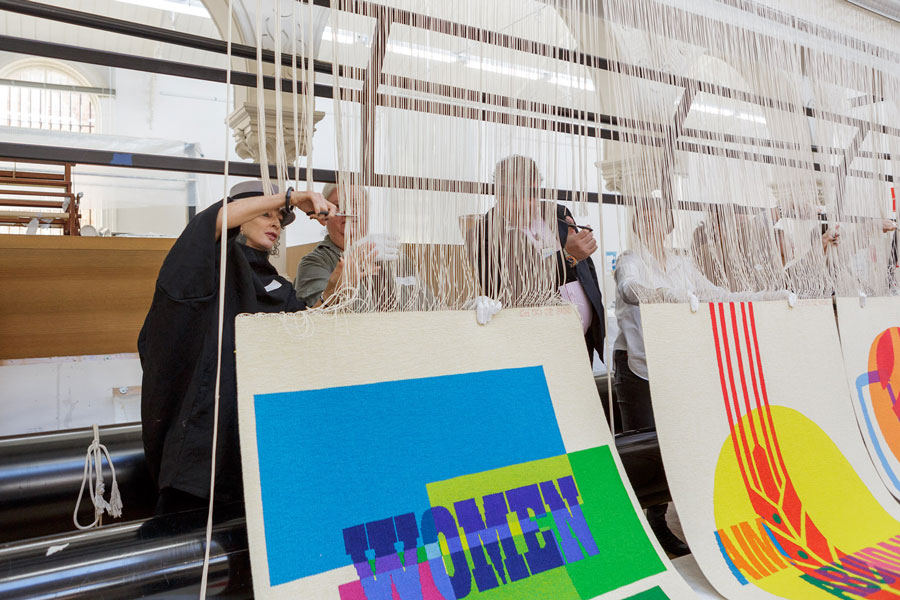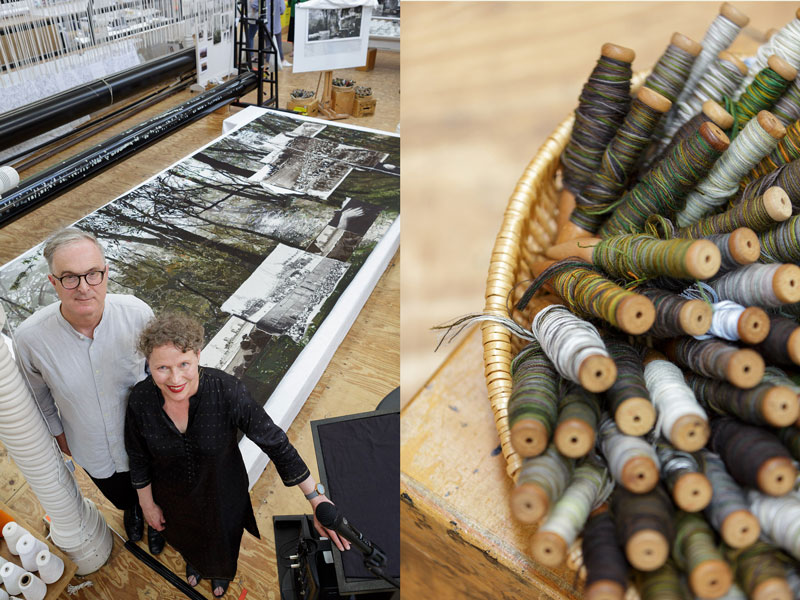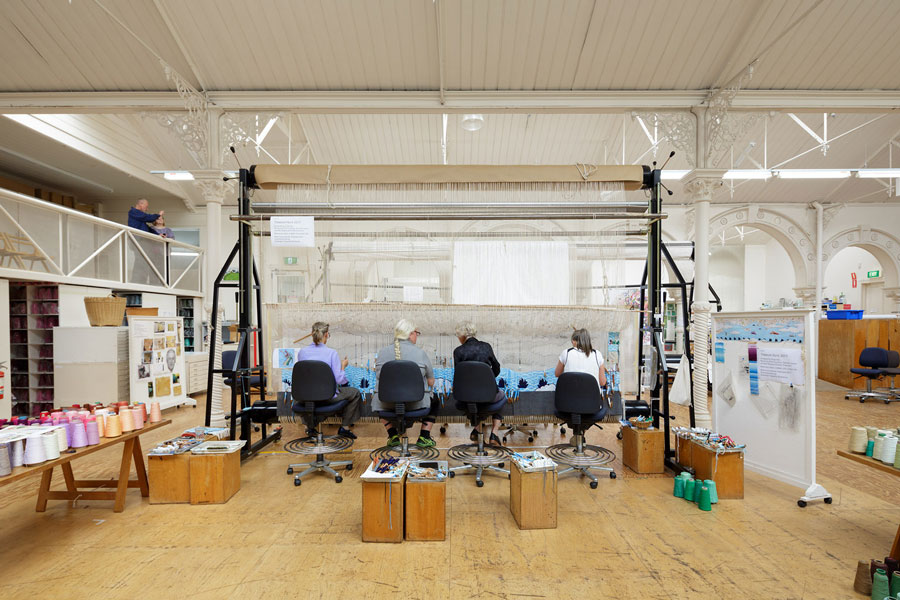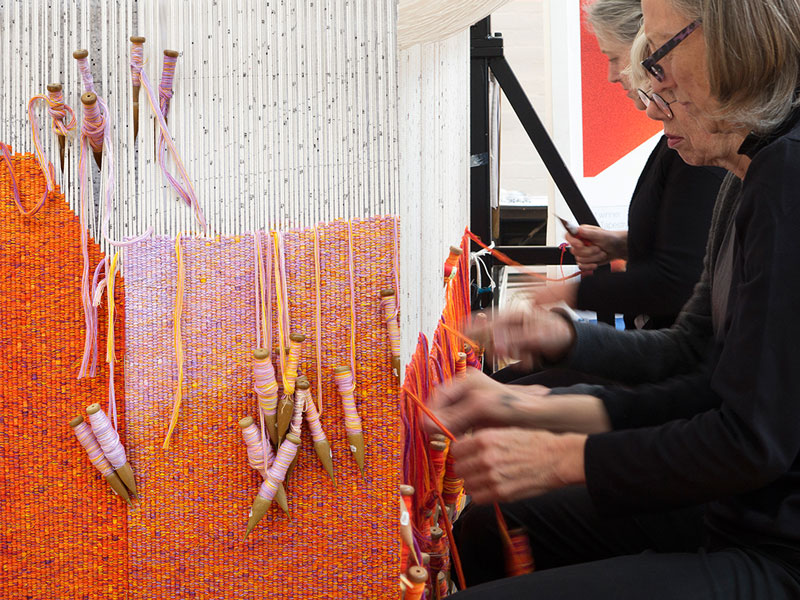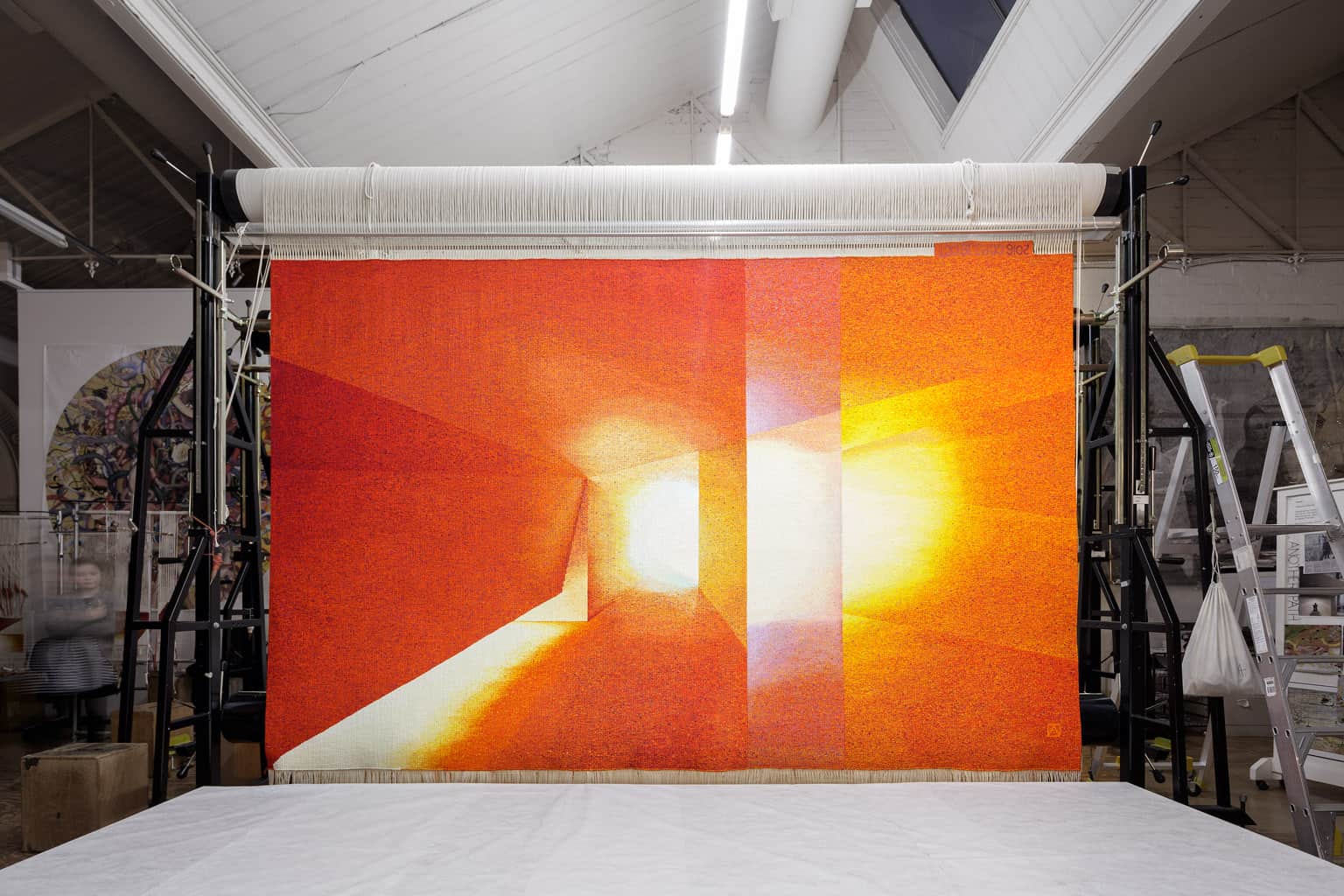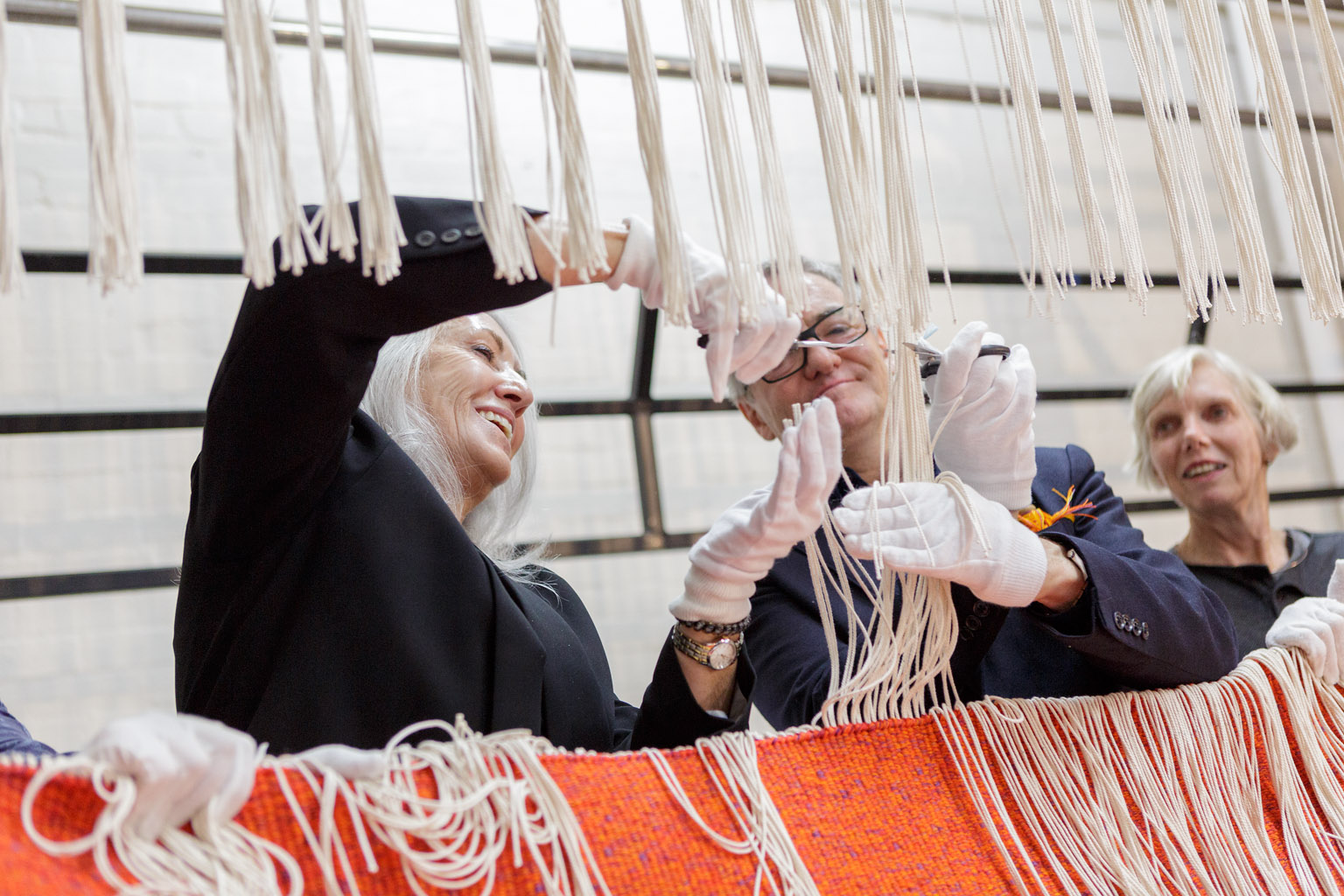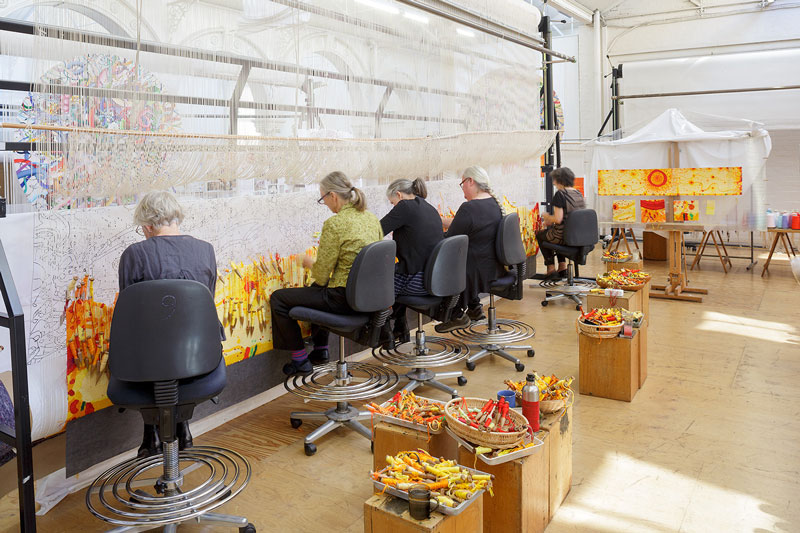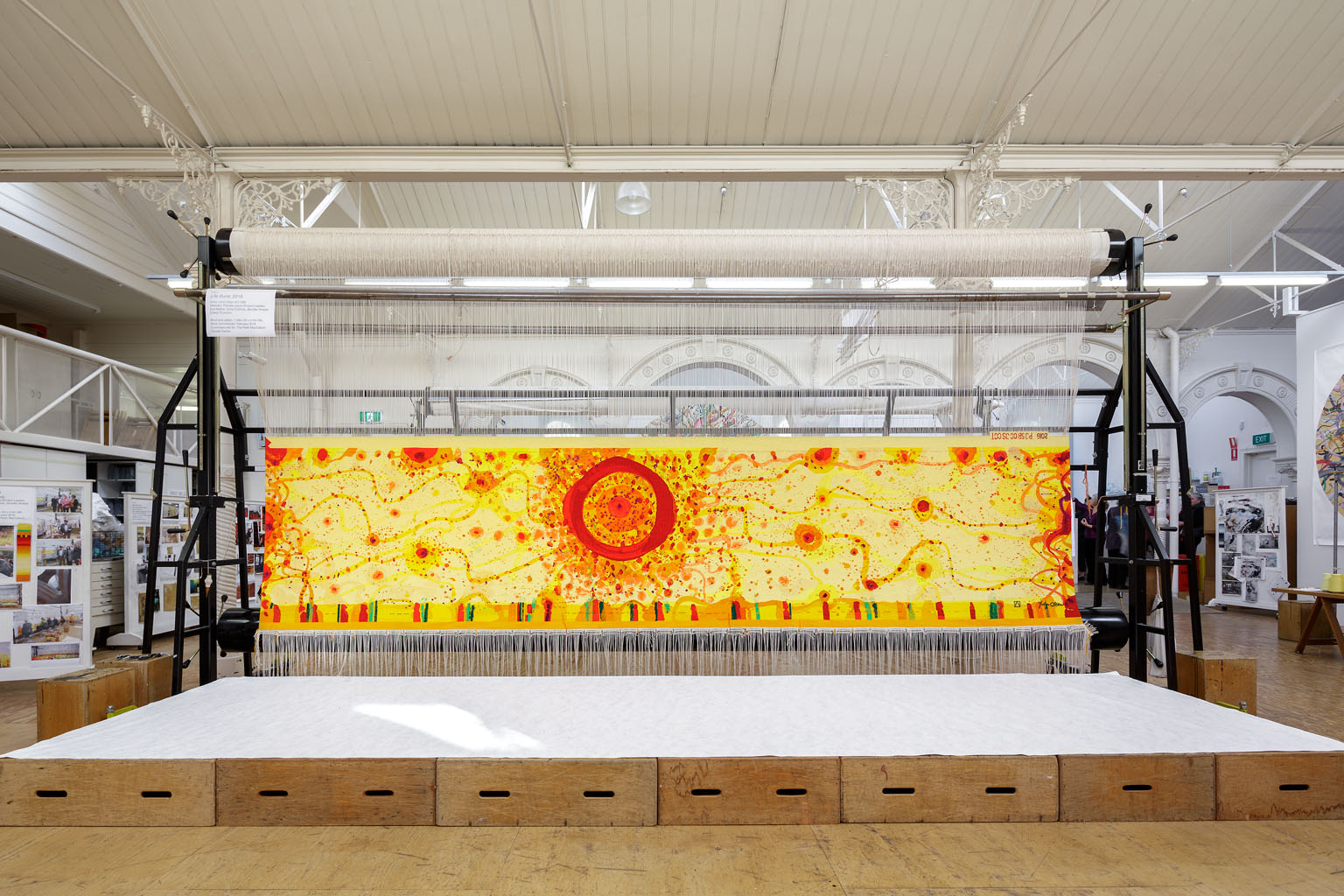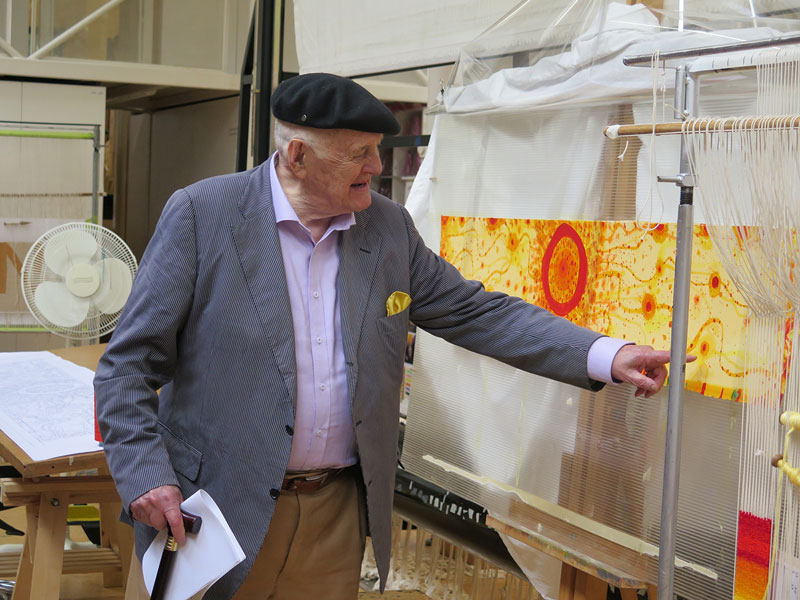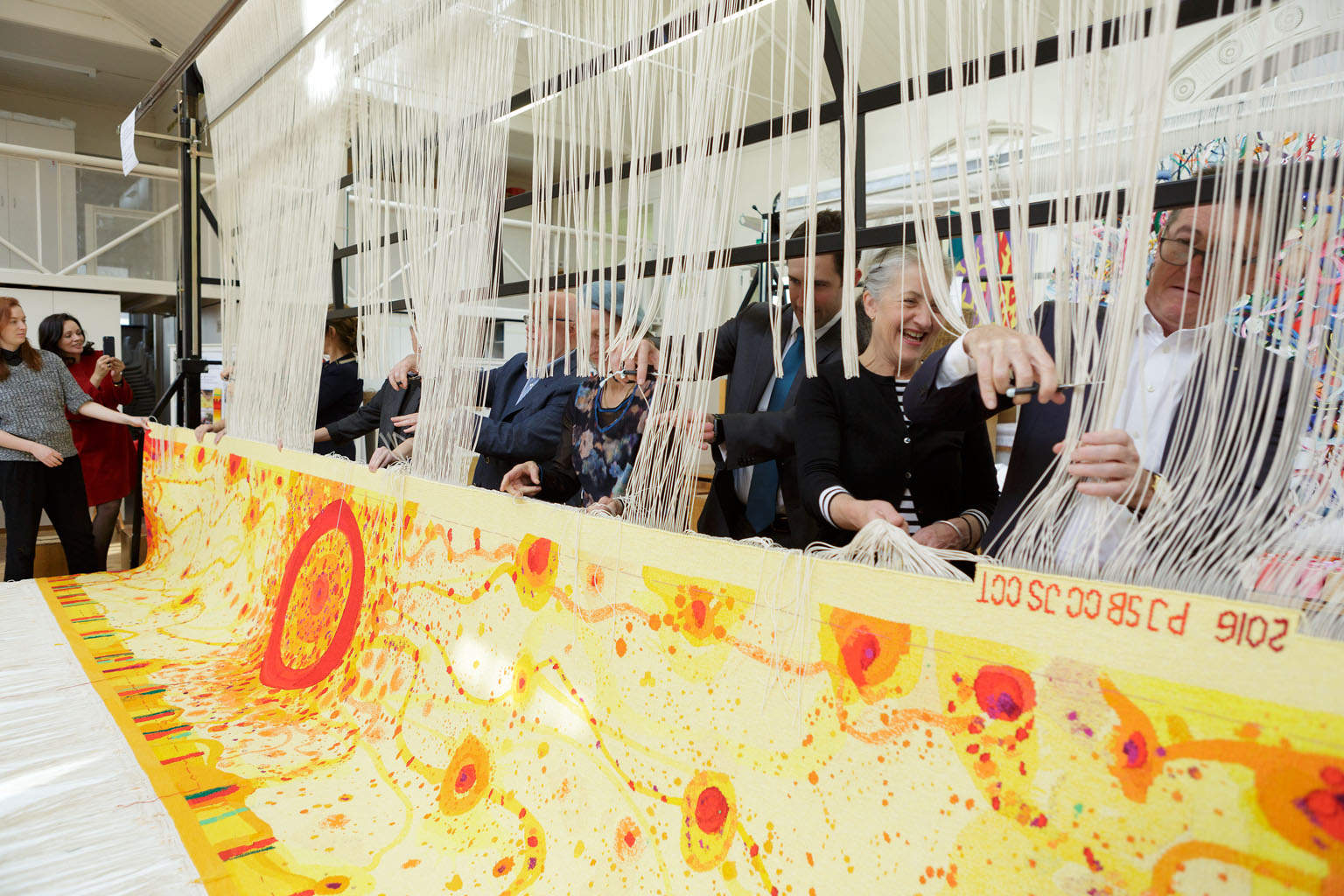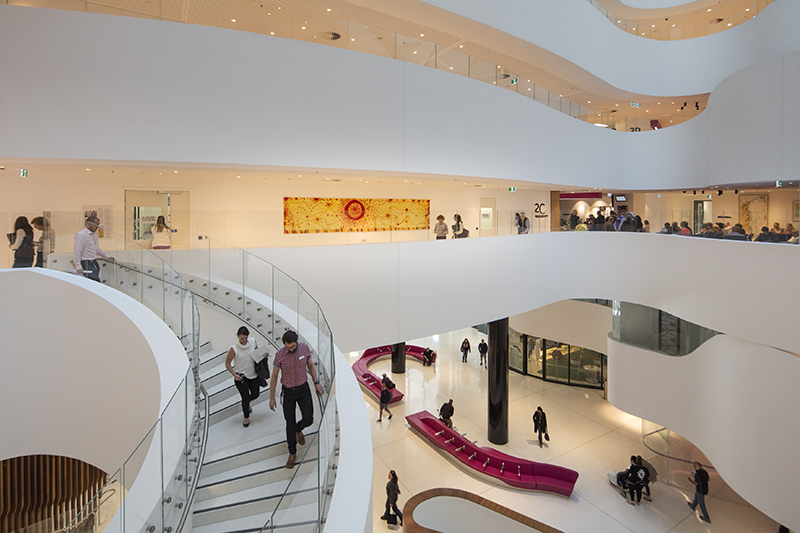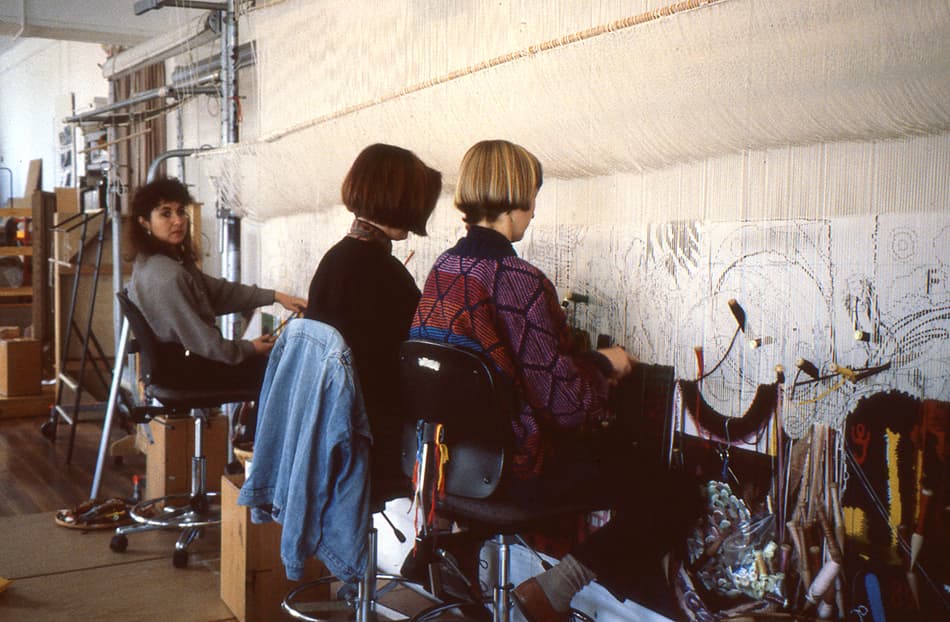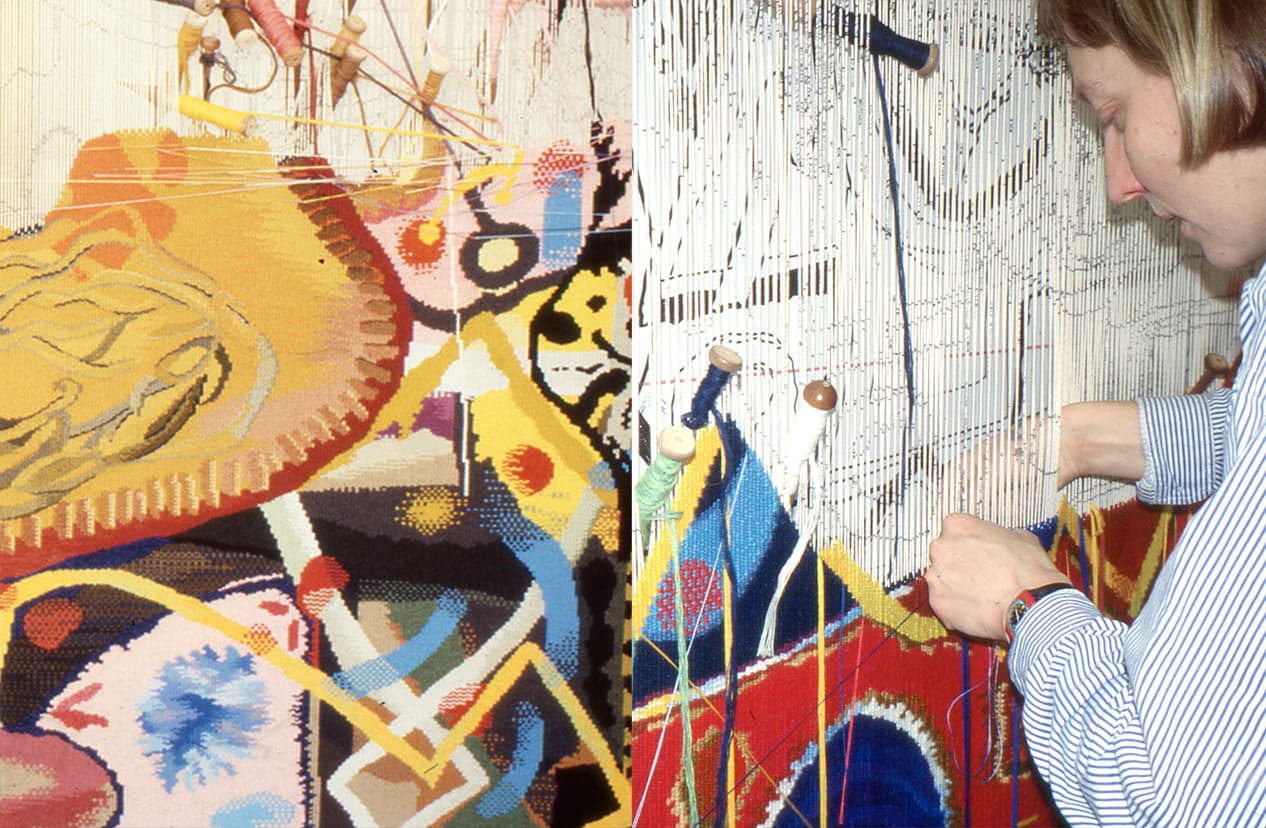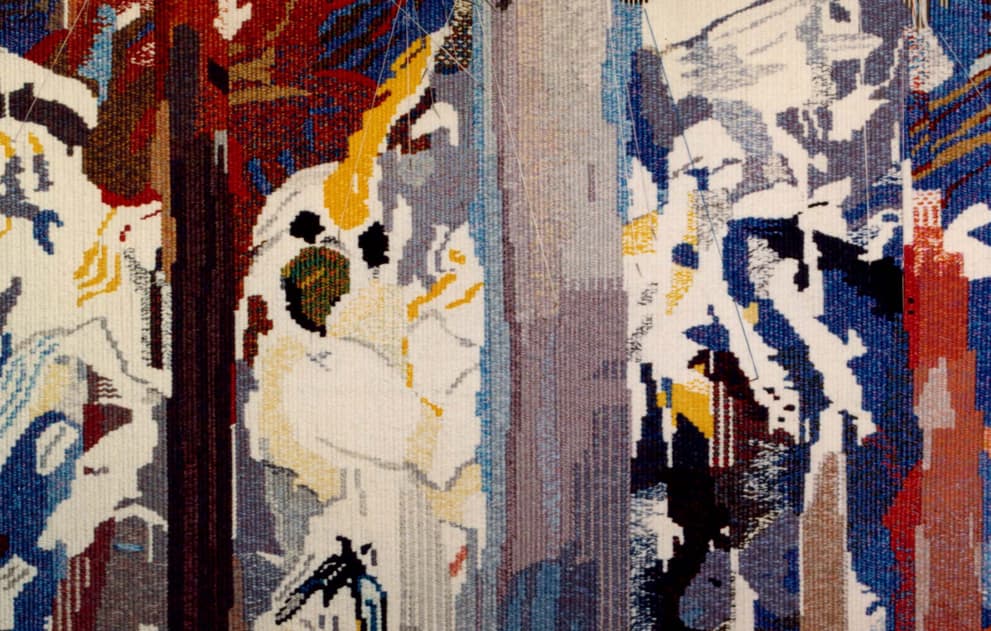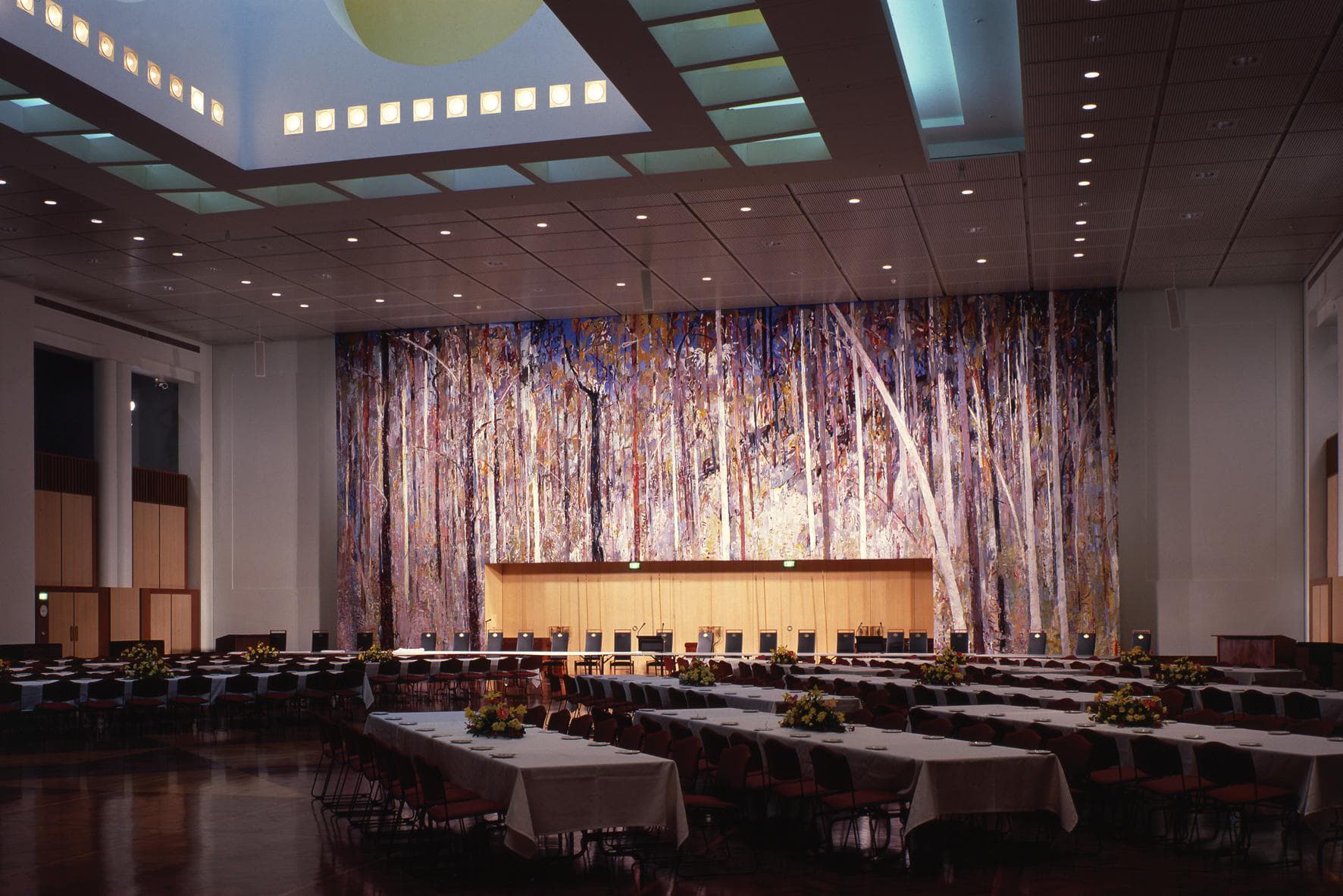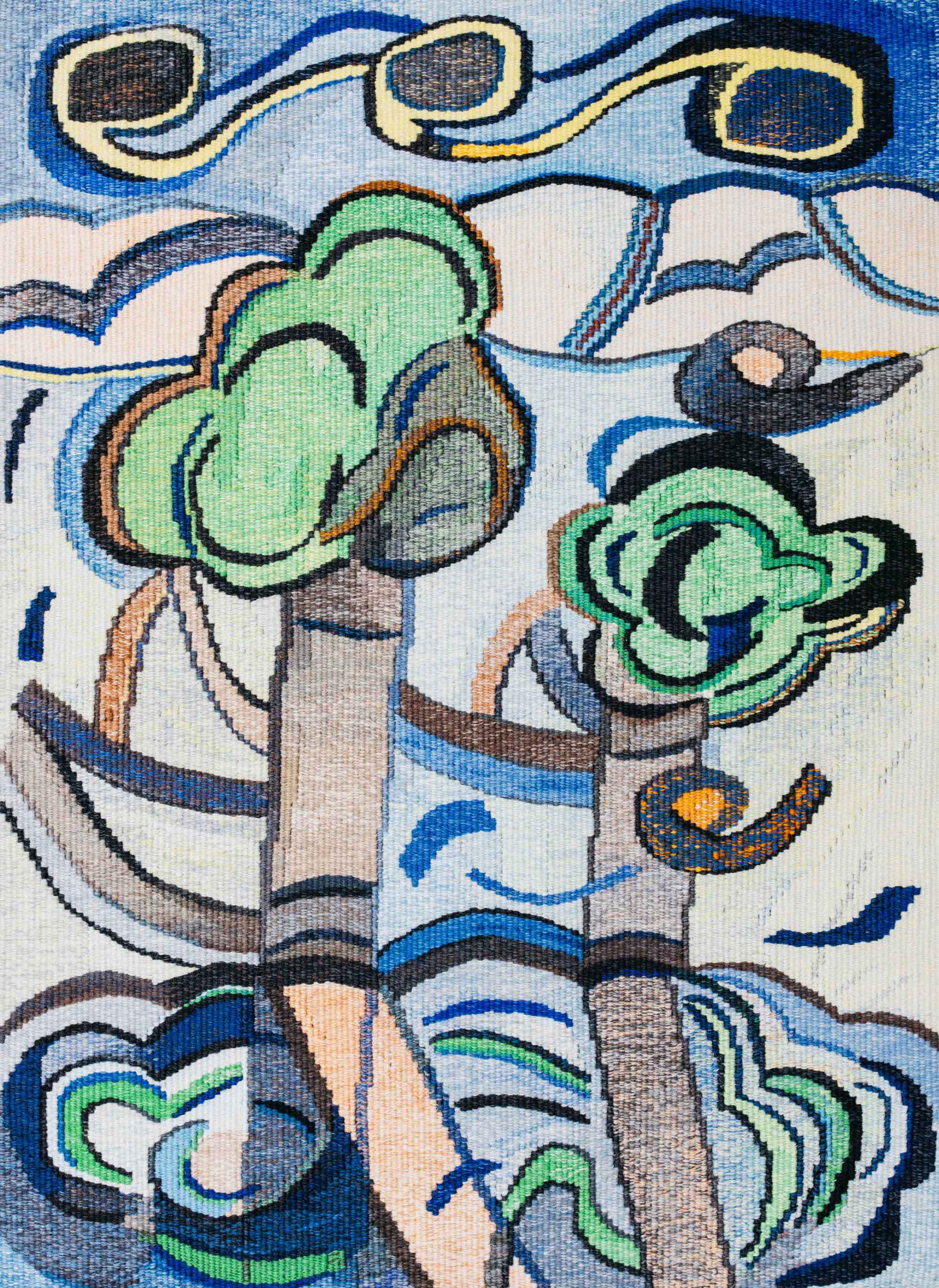
Jennifer Sharpe
With support from the Playking Foundation the ATW commissioned fifteen Australian artists to develop tapestry designs in 2020 as part of the ongoing Weaving Futures project. 'Planted Together' was one of designs created by Emily Ferretti for the Weaving Futures and in 2022 was selected to be woven offsite in ATW Senior Weaver Jennifer Sharpe’s Castlemaine studio. Emily writes:
‘When making the 'Planted Together' drawings I was thinking of the connection between pencil line and thread line and the translation from one to the other. I was very attracted to the connection between the visual effects of mixing coloured threads on a spool and the layering of pencil colours that can create a similar depth and mottled effect. I experimented with the motifs of the two trees in ‘Planted Together’ as a way of representing ideas around human connection and growth with the trees touching each other almost in a dance. I wanted to create movement in the work by using graphic representations of wind and cloud forms in the swirling shapes at the top of the work, and by using reflections, shadows and water motifs at the bottom of the work’
'Planted Together' was woven with number 18 warp at 3 warps per cm, predominantly using wool with additional cotton to provide sheen and colour brightness. Colour mixes on the bobbins were quite varied, with all 6 strands being different colours. This results in a flecky quality that reflects the many small fine pencil marks in Emily's drawing. Jennifer Sharpe has captured the movement and lyrical mark making in the original design in her woven interpretation through this colour mixing process.
Emily Ferretti is a painter whose figurative and abstract images derive equally from collected images, memory and the imagination. As a result her images mirror their conception, hovering between representation and abstraction. Recurring motifs include rural and domestic scenes and while they are devoid of people, their presence is palpable. Ferretti’s paintings engage with a history of picture making across genres and traditions. Dedicated to a full-time studio practice over the past fifteen years, she has exhibited widely and undertaken studio residences including Gertrude Contemporary, Melbourne, Cité Internationale des Arts, Paris, and Green Street Studio, New York.
The Regional Victoria Tapestry Project arose from a desire to deliver creative engagement with and opportunities for regionally-based artists and weavers. For this project, Castlemaine-based, ATW weaver, Jennifer Sharpe wove translations of two sections of Yorta Yorta, Mutti Mutti and Boon Wurrung artist Lee Darroch’s 'Lyrebird Songline' possum skin cloak.
Darroch has lived and worked as an artist and community cultural worker on Raymond Island, Gippsland Lakes, for over 30 years. She is renowned for the revival of traditional cultural practices across South-eastern Australia, particularly possum skin cloak making, feather-work, and coiled basketry. The ATW first connected with Darroch and her practice when she participated in the 2019 Artist in Residence Program. During her residency, Darroch identified similarities between the labour-intensive task of making a traditional Possum skin cloak and tapestry construction, and here a discussion began regarding the possibility of a tapestry collaboration. Skins are gathered, stretched and cured and sewn together with kangaroo sinew, and then decorated with designs depicting stories of clan and Country. Cloaks are used to keep warm, protect infants, carry and tell stories, and play an essential role in ceremonies.
Working from her home studio in Castlemaine, Sharpe used a #12 warp at 3.5 warps per cm and 5 to 6 strands of yarn, a mix of ATW wool and cotton, per bobbin. Sharpe chose to emphasise the slit between tapestry warps to highlight the seam where the possum skin panels join and focused on the cloak’s subtle nuances, including the creases of the textile, stitching and application of ochre paint.
'Lyrebird Songline #1' and 'Lyrebird Songline #2' are generously supported by Creative Victoria.
In February 2021, the ATW completed weaving on 'The Royal Harvest' tapestry, designed by Kaantju/Umpila artist Naomi Hobson, for the Australian Embassy to Indonesia, Jakarta. 'The Royal Harvest' is the tenth tapestry woven for the Embassy Tapestry Collection. This innovative cultural program places ATW tapestries, designed by Australian Indigenous artists, on loan to overseas diplomatic posts.
Hobson is well known for her vibrant abstract compositions that are inspired by her culture and the vast traditional lands of her ancestors, that surround her hometown of Coen, in Far North Queensland. Hobson's more recent paintings have drawn on the richness of cultural diversity, experienced while exploring village life, rural farmlands and the urban organised chaos throughout South East Asia. Through a colourful multitude of layered forms and patterns, 'The Royal Harvest' tapestry evokes an environment brimming with life. Hobson says her tapestry design ‘represents the bounty left behind from our ancient trades between my people in Cape York and Indonesians. The shapes suggest trading movement through country and the colours are capturing the energy, joy, abundance and excitement of trading between the two cultures’.
ATW weavers Pamela Joyce, Sue Batten, Tim Gresham and Jennifer Sharpe have delighted in weaving 'The Royal Harvest' – achieving a robust interpretation of Hobson's bold and expressive design. The weavers have mixed a wide range of hues and tones to render Hobson's palette, which encompasses both pastel and bright colours, overlapped with contrasting outlines in dark and light tones. In tapestry form, the weavers maintained the structural lines of the design by deftly harnessing and controlling the edges of each shape. Woven on a 24 warp at 2.5 warps per cm, with nine strands of yarn per bobbin, the tapestries' wefts are predominately wool, with small amounts of cotton used in lighter areas to achieve contrast and clarity.
The ATW was thrilled to welcome Hobson to our South Melbourne workshop in February 2020 to discuss her tapestry design with the ATW weavers and to see the progress that had been made on the loom.
Originally 'The Royal Harvest' was to be unveiled in Jakarta in July 2020; unfortunately, the COVID-19 pandemic disrupted this plan. Due to physical distancing measures, production on this tapestry was slowed significantly. However, the continued weaving of this joyous tapestry has been a positive tonic for the challenges met by the ATW in 2020.
'The Royal Harvest' tapestry is generously funded by the Myer Family in memory of Arnold Hancock OBE. A significant figure in the ATW's history, Hancock served on the Board of Directors from 1987–2001, including holding the role of Chairman from 1989–1993. In 1995, he was integral in establishing the Tapestry Foundation of Australia, appointed its founding Chairman, continuing as a Trustee from 2003–2007, and Emeritus Trustee until 2018. In 2004, together with Gordon Darling AC, Hancock initiated the Embassy Tapestry Collection, raising funds for the ATW to weave 'Lumpu Lumpu Country' designed by Daisy Andrews, which currently hangs in the Australian Embassy to Japan, in Tokyo. 'The Royal Harvest' is a fitting tribute to Hancock's visionary thinking, passionate advocacy and unstinting commitment to Australian tapestry for decades.
In 2018 ATW collaborated with artist Emily Floyd on ‘The Declaration of the Rights of the Child’, a commission for the new Joan Kirner Women’s and Children’s Hospital in Sunshine, Victoria.
Joan Kirner (1938 - 2015) was an Australian politician and the first female Premier of Victoria. She was a fierce advocate for gender equality, social inclusion and education.
The original artwork stems from the artist’s long-term research in the Ruth and Maurie Crowe Archive at the Victoria University Special Collections Library in Footscray. The Crow Archive includes significant printed materials and working papers that relate directly to the experiences of women and children in the western suburbs of Melbourne. Amongst the materials contained in the collection are several of Kirner’s writings, as well as pioneering works in relation to urban planning, community building and sustainability.
Floyd has reimagined and overlapped archival publication images from the Crow Collection to create colourful and commanding works for a contemporary audience. Amongst the materials referenced includes the artist’s tribute to the 1989 recognition of the ‘Declaration of the Rights of the Child’, and the 1975 ‘Women of the West’ publication, originally produced by the Sunshine Childcare Cooperate on the ‘needs of Sunshine women and their families’. The process of translating community history through the medium of tapestry weaving celebrates women’s contributions to society and will provide a playful and optimistic centerpiece for the new hospital.
Each of the three tapestries measures 2 x 1.3 m and will be suspended on curved battens in the main foyer of the hospital. As the artwork will be visible from both sides of the tapestry, the weavers have meticulously woven in the yarn ends to ensure that each image remain clear.
These tapestries have been funded by the Tapestry Foundation of Australia, the State Government of Victoria and the Australian Hotels Association.
In 2017 a major new tapestry, Morning Star was commissioned for the new Sir John Monash Centre (SJMC) in Villers-Bretonneux, France. Morning Star was designed by prominent Australian artists Lyndell Brown and Charles Green.
The tapestry was generously supported by the Tapestry Foundation of Australia, Australian Hotels Association, ANZAC Centenary Arts and Culture Fund, Marjorie M. Kingston Charitable Trust, Calvert-Jones Family, Anne and Mark Robertson OAM, Baillieu Myer AC and Sarah Myer, Yulgilbar Foundation, Chasam Foundation and the Myer Foundation.
The SJMC was designed by Cox Architects and Convergence Associates to create an evocative, emotional, informative and educational experience for visitors. The Centre will provide a lasting legacy in perpetuity commemorating the 46,000 Australian lives lost in the battles of the Western Front in World War 1 and will commemorate the Centenary of ANZAC.
Of the tapestries lasting contribution and symbolism, Brown and Green noted:
“Just as the SJMC provides both Australian and non-Australian visitors with an understanding of the impact of Australia’s involvement on the Western Front through an engagement with the places in which the Australians fought and the experiences of those who were there, so this tapestry aims to communicate to non-Australians and to Australian pilgrims an understanding of the places for which the Australians fought and the imaginary spaces that they carried with them.
The tapestry seeks to evoke the experience of arrival at a war, and in particular of Australians at the Western Front. With them on their arrival were their memories of Australia and their departure from home. These are the subjects of the tapestry. This tapestry aims to evoke the soldiers’ pathway from home to the Front, and emphasizes the incongruity between the Australia that they imagined as they journeyed further towards the Front. It seems to us that it is absolutely essential, first, to evoke a mental place of Australian freedom and clear light; and, second, to evoke the sea-borne passage towards the soldiers’ arrival at the Front. The tapestry emphasises the disjunction between the terrible experiences that the museum describes rather than repeats them.
There are two personal contexts that we offer to illuminate our work. Charles Green’s grandfather served as an Australian soldier on the Western Front. He was gassed and lived the rest of his life as an invalid, as a deeply disturbed shadow. Although he died decades before Green was born, that WW1 tragedy was very present in his family and especially with his grandmother, by then a war widow. And interestingly, she spoke often about the soldiers’ love of Sir John Monash, describing him to us with great devotion. Second, in 2007 we were Australia’s Official War Artists, deployed into Iraq and Afghanistan for a period longer than any War Artist since the program was reinstituted in 1996, and during those deployments we spent all our time amongst soldiers on active duty, surprised by their complete support for war artists and humbled by their sense of public service. Ever since, our art has been dominated by reflections on the aftermath of war and the survival of the past into the present."
The overall image shows dawn light, during winter, illuminating a pathway through eucalypt trees and bush towards sunlight. The inset images are a combination of departures to war by ship from Australia, punctuated by visual comments (snaps of these young men, those who were about to enlist). We have deliberately chosen to make these images almost monochromatic—very tonal with a subtle but definite minimum of colour—as the weavers at ATW have repeatedly demonstrated enormous, subtle virtuosity in translating very tonal images with precise grey ranges into tapestry.
Morning Star was unveiled at the official opening of the SJMC in April, 2018.
Lyndell Brown and Charles Green are represented by Arc One Gallery.
Guan Wei’s Treasure Hunt explores the impacts of globalisation through the legend of admiral Zheng He. Shifting levels of detail in the design provided a challenging opportunity for ATW weavers to work with two different warp sets.
The design is inspired by a large painted mural from Guan Wei's exhibition Other Histories at the Powerhouse Museum, Sydney in 2006. Through the depiction of oceans, islands and desert interiors, Wei references navigation, exploration, migration and the influence of globalisation and cultural diversity. Other Histories was inspired by one of the Powerhouse Museum’s most mysterious objects: a small figure of the Chinese God of Longevity, unearthed in Darwin in 1879. Many writers and historians have suggested that the God of Longevity may be evidence of the arrival of a Chinese vessel from the voyages of Zheng He (1371-1432) in the early 15th century, more than 350 years before James Cook landed at Kurnell.
The eunuch admiral Zheng He led a legendary fleet of “treasure ships”, on which thousands of men set sail for foreign lands. Over nearly three decades, from 1405 to 1433, Zheng He made a series of official voyages, visiting numerous strange and wonderful places. Zheng He and his men collected rare spices, marvellous treasures and wondrous birds and animals. On these voyages the crew navigated new ocean routes and created nautical maps. Treasure Hunt represents the flora and fauna Zheng He might have encountered on his travels, including sea monsters drawn from Chinese and European mythology. The land shapes in the design reference 14th century Chinese maps. The Chinese symbols for East and West and the names of mountains have been painted in as well. Each smaller drawing within the work has a significance within European or Asian history, contributing to the overall narrative of the design.
The weavers worked with two different warp sets for this project. Double warps (two warps per bead) were used for the oceans and land, and single warp (one warp per bead) were used for the animals and other small details. This enabled the weavers to capture fine detail in the creatures, without having to add too much detail to the oceans and land. The weavers used more cotton than wool for this project to give the tapestry an appropriate lustre.
Guan Wei is represented by Arc One Gallery.
John Wardle Architect’s Perspectives on a Flat Surface was the winner of the inaugural 2015 Tapestry Design Prize for Architects (TDPA). Funded by Judith Neilson AM, Perspectives on a Flat Surface was the first TDPA design to be translated into tapestry.
John Wardle Architect’s (JWA) were awarded joint first prize for the TDPA in 2015, along with a design by Kristen Green (director of KGA Architecture) with Michelle Hamer, entitled Long Term Parking. The designs were produced for the hypothetical site of the Australian Pavilion in the Giardini in Venice, designed by Denton Corker Marshall.
Having drawn inspiration from The Teatro Olimpico, JWA state:
"The Teatro Olimpico in Vicenza designed by Palladio, houses Vincenzo Scamozzi’s trompe l’oeil street scenes. The design is renowned for creating the exaggerated perspective from each of Palladio’s grand portals. Our design refers to our own exchange between Italy and Australia. A series of imagined sets have been created that reverse Scamozzi’s inverted perspectives, forming a series of picture planes drawn toward the audience. Each multiplies shifting perspectives across one wall whilst allowing another to exaggerate the proportions of the space. The partial views and variant transmissions of light within each inverted chamber suggest a place that is ‘elsewhere’."
JWA have designed a new art gallery, performance space and garden for Neilson, founder of White Rabbit Gallery, with Durbach Block Jaggers, artist Janet Laurence and timber craftsman Khai Liew.
John Wardle Architects are based in Melbourne, Victoria.
Commissioned for the Peter MacCallum Cancer Centre in Melbourne in 2016, Life Burst is the ninth John Olsen AO OBE designed tapestry to be produced by the ATW.
In 2016 Life Burst was unveiled at the new Peter MacCallum Cancer Centre, a project of the Victorian Comprehensive Cancer Centre (VCCC). The VCCC delivered a $1 billion facility purpose-built for cancer research, treatment, education and care. The project was produced by the design consortium Plenary Health; builders’ Grocon PCL, architectural design teams Design Inc. and Silver Thomas Hanley, in partnership with McBride Charles Ryan.
As one of Australia’s greatest living artists, Olsen realises the creative potential of tapestry as a medium and has designed specifically for tapestry, following in the footsteps of some of the greatest artists in history, such as Rubens and Raphael. Olsen’s work is marked by a deep engagement with the Australian landscape. Having travelled widely through different parts of the country, Olsen describes his work as “an exploration of the totality of landscape”. Including the sun-like motif that is synonymous with Olsen’s practice, Life Burst was also designed to reflect the architectural rhythms of the atrium where the tapestry has been installed. Olsen visited the ATW to collaborate with weavers throughout the design process.
The weavers employed soumak (a supplementary weft technique) to accentuate certain areas of the tapestry. The majority of the tapestry has been woven with cottons to achieve a more silken effect and a lightness and transparency in the yellows and oranges. ATW yarn dyer Tony Stefanovski created several new tones of orange for this project.
The creation of Life Burst was generously supported by the Australian Hotels Association, Anne and Mark Robertson OAM, Janet Calvert-Jones AO and John Calvert-Jones AM through the Tapestry Foundation of Australia.
The ATW was thrilled to weave Family Trust, designed by prominent Australian artist who was dubbed the bad boy of the Melbourne art scene in the 1970s-80s, Gareth Sansom.
Sansom’s painting has always been styled as a provocation to middle-class taste. His painting is expressionistic, replete with iconoclastic and sexually explicit imagery. Motifs from popular culture are interspersed with distorted figures and combined into a personal mythology: the canvases teem with manic energy, punk references and rebellious humour.
Family trust is an image brimming with contorted, spewing faces with disembodied eyes, all writhing in a patch worked pattern. The image is claustrophobic, packed with energy and agitated movement, and layered motifs jostling for attention.
Unlike most artists commissioned by ATW, Sansom did not desire active collaboration during the development of his tapestry. Once the design was finalised, he sought no further involvement in the tapestry’s evolution. However, after its completion he confessed that his curiosity had been so piqued that while the work was in progress he prowled around the Workshop at night, attempting to catch glimpses of the tapestry on the loom.
Family Trust is part of the ATW’s collection and was exhibited in a major retrospective of Sansom’s work, entitled Transformer, at the National Gallery of Victoria in 2017-18.
Sansom’s work has been exhibited widely in national and international institutions. He is represented by Milani Gallery in Brisbane.
The ATW produced the monumental Great Hall Tapestry, spanning 9.18 x 19.9m, and designed by prominent Australian artist Arthur Boyd, for Parliament House in Canberra in 1988.
Boyd (1920-1999) is considered to be one of Australia's most distinguished 20th-century artists. He came from the Boyd dynasty of painters, sculptors, ceramicists and architects, and was part of the Angry Penguins school in the 1940s and later the Antipodeans, which included John Perceval and Charles Blackman. Boyd represented Australia at the Venice Biennale in 1958 and again in 2000. In 1979 he was awarded an Order of Australia, augmented by a Companion of the Order of Australia in 1992.
The design of Parliament House in Canberra was won by architect Romaldo Giurgola in 1979, and created the opportunity for the commission of a major public artwork. As an eminent living artist Arthur Boyd was offered the chance to produce an artwork that would cover almost the entire south wall of the Reception Hall. Extensive discussions ensued about the best medium to suit this scale, and tapestry was decided on as the ideal choice.
The tapestry design represents a forest of towering eucalyptus trees from the grounds of Boyd's rural retreat and studio at Bundanon. The tree-scape is quintessentially Australian, a homage to the majesty of the bush. Strong vertical rhythms structure the work, and the life-like proportions of the trees recreate the enveloping feel of a forest setting, fulfilling the architect's brief that the entire wall would almost appear as a three-dimensional living landscape.
The massive scale of the work - an astonishing nine meters in height and almost twenty meters in width - makes it the second largest tapestry in the world. It was woven in vertical sections by 12 weavers over a two-year period, and remains the most ambitious tapestry the Workshop has ever produced.
Arthur Boyd’s legacy is maintained through the Bundanon Trust collection and many major collections in Australia and overseas.

